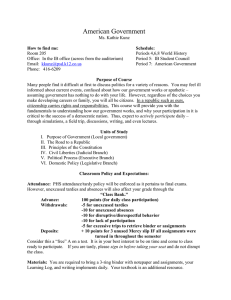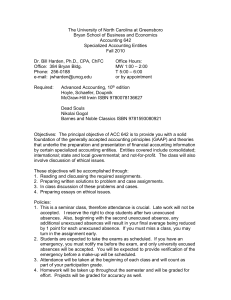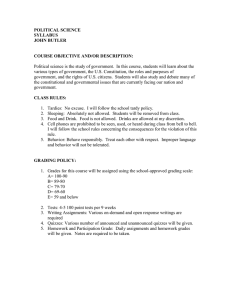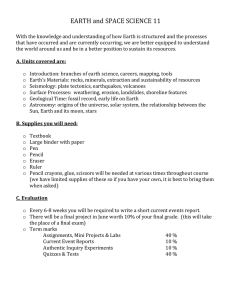IC 1010 Drawing I MVHS Course Information Sheet ...
advertisement
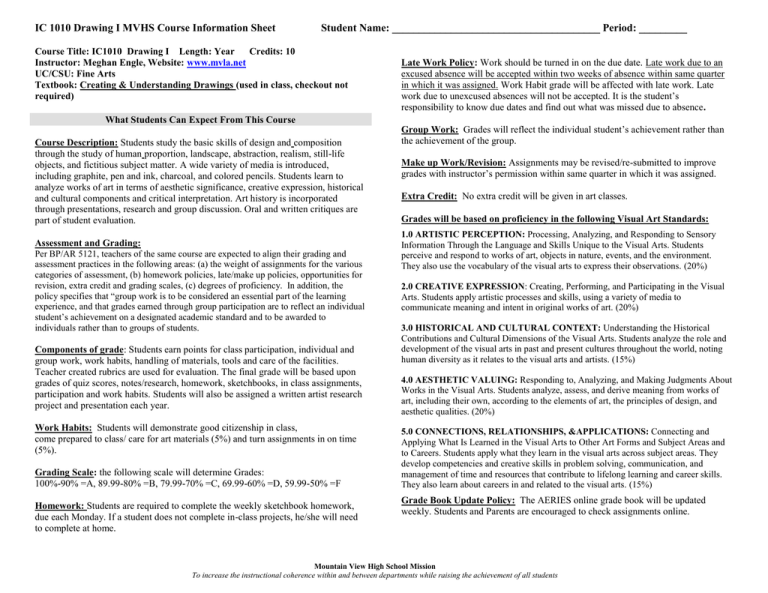
IC 1010 Drawing I MVHS Course Information Sheet Student Name: _______________________________________ Period: _________ Course Title: IC1010 Drawing I Length: Year Credits: 10 Instructor: Meghan Engle, Website: www.mvla.net UC/CSU: Fine Arts Textbook: Creating & Understanding Drawings (used in class, checkout not required) What Students Can Expect From This Course Course Description: Students study the basic skills of design and composition through the study of human proportion, landscape, abstraction, realism, still-life objects, and fictitious subject matter. A wide variety of media is introduced, including graphite, pen and ink, charcoal, and colored pencils. Students learn to analyze works of art in terms of aesthetic significance, creative expression, historical and cultural components and critical interpretation. Art history is incorporated through presentations, research and group discussion. Oral and written critiques are part of student evaluation. Assessment and Grading: Per BP/AR 5121, teachers of the same course are expected to align their grading and assessment practices in the following areas: (a) the weight of assignments for the various categories of assessment, (b) homework policies, late/make up policies, opportunities for revision, extra credit and grading scales, (c) degrees of proficiency. In addition, the policy specifies that “group work is to be considered an essential part of the learning experience, and that grades earned through group participation are to reflect an individual student’s achievement on a designated academic standard and to be awarded to individuals rather than to groups of students. Components of grade: Students earn points for class participation, individual and group work, work habits, handling of materials, tools and care of the facilities. Teacher created rubrics are used for evaluation. The final grade will be based upon grades of quiz scores, notes/research, homework, sketchbooks, in class assignments, participation and work habits. Students will also be assigned a written artist research project and presentation each year. Work Habits: Students will demonstrate good citizenship in class, come prepared to class/ care for art materials (5%) and turn assignments in on time (5%). Grading Scale: the following scale will determine Grades: 100%-90% =A, 89.99-80% =B, 79.99-70% =C, 69.99-60% =D, 59.99-50% =F Homework: Students are required to complete the weekly sketchbook homework, due each Monday. If a student does not complete in-class projects, he/she will need to complete at home. Late Work Policy: Work should be turned in on the due date. Late work due to an excused absence will be accepted within two weeks of absence within same quarter in which it was assigned. Work Habit grade will be affected with late work. Late work due to unexcused absences will not be accepted. It is the student’s responsibility to know due dates and find out what was missed due to absence. Group Work: Grades will reflect the individual student’s achievement rather than the achievement of the group. Make up Work/Revision: Assignments may be revised/re-submitted to improve grades with instructor’s permission within same quarter in which it was assigned. Extra Credit: No extra credit will be given in art classes. Grades will be based on proficiency in the following Visual Art Standards: 1.0 ARTISTIC PERCEPTION: Processing, Analyzing, and Responding to Sensory Information Through the Language and Skills Unique to the Visual Arts. Students perceive and respond to works of art, objects in nature, events, and the environment. They also use the vocabulary of the visual arts to express their observations. (20%) 2.0 CREATIVE EXPRESSION: Creating, Performing, and Participating in the Visual Arts. Students apply artistic processes and skills, using a variety of media to communicate meaning and intent in original works of art. (20%) 3.0 HISTORICAL AND CULTURAL CONTEXT: Understanding the Historical Contributions and Cultural Dimensions of the Visual Arts. Students analyze the role and development of the visual arts in past and present cultures throughout the world, noting human diversity as it relates to the visual arts and artists. (15%) 4.0 AESTHETIC VALUING: Responding to, Analyzing, and Making Judgments About Works in the Visual Arts. Students analyze, assess, and derive meaning from works of art, including their own, according to the elements of art, the principles of design, and aesthetic qualities. (20%) 5.0 CONNECTIONS, RELATIONSHIPS, &APPLICATIONS: Connecting and Applying What Is Learned in the Visual Arts to Other Art Forms and Subject Areas and to Careers. Students apply what they learn in the visual arts across subject areas. They develop competencies and creative skills in problem solving, communication, and management of time and resources that contribute to lifelong learning and career skills. They also learn about careers in and related to the visual arts. (15%) Grade Book Update Policy: The AERIES online grade book will be updated weekly. Students and Parents are encouraged to check assignments online. Mountain View High School Mission To increase the instructional coherence within and between departments while raising the achievement of all students What Is Expected Of The Student Daily Assignments: 1) Right brain trigger activities to induce the drawing mode. 2) Pencil line drawings defining contour shapes. 3) Shading of basic shapes and simple objects. 4) Reading, note taking, and discussion 5) Individual and group work, collaboration. 6) Working on a collaborative drawing with the entire class. 7) Create renderings using various 2D materials. 8) Use pen and ink to draw simple objects and landscapes. 9) Create drawings using perspective application. 10) As time allows, additional materials and techniques will be taught. School-wide Learner Outcomes: 1) Critical Thinking Skills: Students analyze works of art and interpret the meaning. 2) Problem-solving Skills: Use acquired drawing skills to find solutions to creative problems. Students learn to use the elements and principles of design into harmonious, balanced compositions. Students work individually and together to solve problems. 3) Communication Skills: During verbal critiques and student led presentations, students learn to effectively express concepts. Through making art, students learn to use images to express an idea. 4) Knowing how to learn: Students learn note taking skills, reading, research, and how to follow steps involved the creative process. By engaging in structured discussion of art, students also learn to value collaboration in the learning process. 5) Creative Skills: Students learn to create art using different two-dimensional techniques. Students develop skills to translate ideas, feeling, and values. Attendance: ABSENCES: An “unexcused absence” is an absence in excess of a 30-minute period occurring in a given class. Students may not exceed 14 unexcused absences across their entire schedule. A full day, unexcused absence counts as 5, 6 or 7 absences depending on how many classes a student carries toward the total of 14. On the 15th unexcused absence, students may be referred to an alternative educational program/site pursuant to the District’s involuntary transfer policy (AR/OP 5113). TARDIES: Students may not exceed 19 unexcused tardies across their entire schedule. An unexcused tardy is an absence from class from when the bell rings until up to 30 minutes of a class period. At the 15th unexcused tardy, there will be a mandatory parent conference with the student’s Assistant Principal. This conference will be scheduled to occur the morning after the family is contacted by the school. At the student/parent conference, consequences for continued tardiness are discussed and the student is assigned to Saturday School. An attendance contract will also be signed at this meeting. Failure to attend Saturday School may result in a transfer to an alternative educational program/site. Classroom Rules: Below is a list of classroom behavior expectations that are in addition to the regular school-wide rules. Additional “Common Sense” rules apply and if necessary other rules will be posted later. See Class Participation Rubric & Class Norms 1) Be in class, seated with art materials and ready to work when bell rings. 2) Read daily agenda on board, participate & work on assigned project/task. 3) Remain in your assigned seat during class, unless you are getting materials or cleaning up. 4) Respect other students’ right to learn by courteous behavior. 5) Listen when teacher, another student or guest presenter is addressing the class. 6) Be engaged in the creative learning process, contribute positively. 7) Work quietly and focused on the class work. 8) Do you own original work to the best of your ability. 9) Eating, chewing gum, beverages or grooming is NOT permitted. 10) Keep and maintain a sketch/ notebook and resources folder for the entire year. 11) No talking or texting, no phones, personal stereos, games or toys allowed in class. I will confiscate anything I see 1st warning, 2nd time it goes to the office. 12) Clean up begins when the teacher announces it, Do Not cleanup early!! Cheating Policy/Academic Integrity The Board expects that students will not cheat, lie, plagiarize or commit other acts of academic dishonesty. Examples of cheating include: anyone who copies another’s work or turns in someone else’s ideas as his or her own, collaboration with another student or students could be considered cheating if students are expected to complete an assignment independently, copying homework, allowing someone else to copy your work, plagiarism, copying or allowing others to copy from another’s exam, improperly obtaining and/or using tests, questions, or answer keys, using unauthorized notes/materials or electronic equipment (calculators, cell phones, etc.), with greater access to the Internet and electronic sources, students need to be very clear about their responsibilities in using these tools with integrity. Check with your teachers if you are unsure or unclear about his/her expectations regarding the use of the Internet. Help, Contact & Donations Information Phone: 940-7468 Email is preferred Email: Meghan.engle@mvla.net Help: Students should always ask for help when they feel it is needed. Students may arrange to meet with teacher during lunch or prep periods. Conferences are available to students and parents by appointment. Please email instructor to set up an appointment. Donations: Each student will be receiving the following fine art materials to use in this art course: Sketchbook, Portfolio, three art pencil sets (graphite, charcoal, color, watercolor), erasers, sharpener, fine tip art pens, markers, and several additional art materials. A donation to the MVHS Drawing Class fund would be greatly appreciated, and can be made online via the MVHS Spartan Web store or In-person at the MVHS Finance office. Recommended donation amount $70.00 Checks payable to MVHS Drawing Class fund Parent/Guardian Signature: Student Signature: _______________________________________________Date: ______________ ______________________________________________Date: ______________ Mountain View High School Mission To increase the instructional coherence within and between departments while raising the achievement of all students
